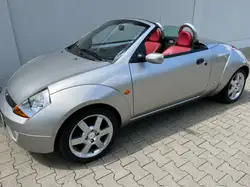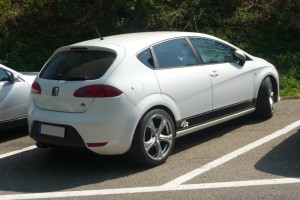
TOP 10 | 90s Supercars You Haven't Heard Of
Ferrari F40? Lamborghini Diablo? Everyone knows these supercars. Is our list less obvious?
1. Isdera Commendatore 112i
Isdera comes directly from Mercedes. The founder of the brand, Eberhard Schulz, was the author of the CW311 sports car concept (1978). The design was not reviewed by management, but Schultz was allowed to produce it himself. It took him several years to get started, but in 1984 the first Isdera Imperator appeared.
The Commendatore 112i is another supercar produced in small numbers by Schulz. The Emperor's successor, introduced in 1993, featured a modern, aerodynamic body with Mercedes-specific gullwing doors. The car was extremely low - its height was only 104 cm.
The Isdera was equipped with a 420-liter V12 engine with 6 hp. Acceleration to 100 km / h took about 4,7 seconds, and the maximum speed was estimated at 340 km / h. In 1999, the Silver Arrow version appeared, featuring a more powerful 620-liter engine with 6,9 hp, also from Mercedes, which allowed it to reach speeds of up to 370 km / h and accelerate to 100 km / h in 4 seconds.
2. Venturi 400 GT
The Venturi 400 GT is a derivative of the Venturi 400 Trophy (1992–1994) track-only racing car.
The characteristic aggressive appearance of the Venturi 400 GT made the car known as the French Ferrari F40. While it lacks the supercar from Maranello a bit in terms of performance, in terms of looks it is a worthy competitor to the latest car designed under the watchful eye of Enzo Ferrari.
Venturi, as is usually the case in small manufactories, used power units from larger manufacturers. The 400 GT was based on the popular 3-liter PRV engine (jointly developed by Peugeot, Renault and Volvo). In Venturi, power is increased to 408 hp. through the use of two turbochargers.
The predatory look went hand in hand with the performance – the car was capable of reaching speeds of 300 km / h, and 100 km / h could appear on the speedometer in about 4 seconds.
The Venturi 400 GT was produced from 1994 to 1996. During this time, 2 prototypes and 13 production units in road performance were created.
3. Vector W8 Twin Turbo
Vector is a niche supercar manufacturer with a history of more than just roses. The company usually didn't do well, but their W8 is certainly a very interesting design.
The car has a lot to do with the turn of the 70s and 80s because it is closely related to the Vector W2, which was completed in 1980 but never went into production. The futuristic W8 went on sale in 1990, and 3 units were produced in 17 years.
The car featured an aggressive design, a futuristic interior and a powerful 660 hp turbocharged engine. Power could be increased by the driver thanks to the ability to change the level of boost. Apparently, the engine was able to develop power in excess of 1200 hp. The manufacturer claimed a top speed of 354 km/h and acceleration to 100 km/h in just over 4 seconds. Before the launch of the McLaren F1, it was the fastest production car in the world, although the problem is that there is no official information that the car actually reached that speed at one time.
4. Koenig C62
The Koenig C62 is one of the most extreme supercars out there, as it's a Le Mans carryover from the Porsche 962. It was the first of its kind, and the car hit German roads in 1991. Later, other companies also prepared their road cars based on the racing Porsche. These were Schuppman 962CR, DP62 and Dauer 962 Le Mans.
The Koenig C62 used the chassis and powertrain (after modifications) from the racing version, but the German tuners prepared a new plastic body that allowed it to pass road approvals.
The Koenig C62 had a 3,3 liter twin supercharged engine with 810 hp. The car weighed only 1100 kg, which allowed for breathtaking performance: a top speed of 378 km/h and acceleration to 100 km/h in 3,3 seconds.
5. Chisetta Moroder V-16
This is what the Lamborghini Diablo should have looked like. The design, however, did not please the then owner of the brand - the Chrysler concern, so the company's chief designer, the legendary Marcello Gandini, left the company. Ultimately, Diablo was based on this design, but went through many changes.
Gandini found an investor who allowed the initial concept to be put up for sale. The Cizeta Moroder V-16 was an Italian flesh-and-blood supercar that differed not only in appearance but also in the power plant used. The heart of the car was a 16-cylinder 6-liter engine with a capacity of 540 hp. The car accelerated to more than 300 km / h, and to 100 km / h it could accelerate in about 4,4 seconds.
Although the project was completed in 1988, the Cizeta Moroder V-16 did not enter production until 1991, but was not warmly received, and the company collapsed in 1994. You can read more about this car and its history in this article.
6. Leblanc Caroline GTR
While some of you may know the cars in the top five, the Leblanc Caroline GTR should be a mystery to just about everyone.
In the small Swiss town of Wetzikon, road-legal racing cars were produced on the track. Light car, small engine, maximum fun. The philosophy of the Leblanc brand was similar to that of Lotus, but the engine, although small (2 liters), was extremely powerful (over 500 hp), which, combined with a weight of only 785 kg and a very aerodynamic silhouette of a racing car, created an explosive mixture . Leblanc Caroline GTR accelerated to 100 km / h in 2,7 seconds and could accelerate to 348 km / h. Total madness worth about 400 thousand. Euro.
7. Lotek S1000
Lotec C1000, produced in a single copy for a Saudi sheikh, is another German supercar from a small factory in Germany that is included in our rating. The car was created in collaboration with Mercedes. It was powered by an 8-litre V5,6 engine from Mercedes and was boosted by two turbochargers.
The car was custom made and the owner wanted the fastest car in the world. The name C1000 comes from power. 1000 HP in 1995. Lotec C1000 was an uncompromising and hellishly fast design - it accelerated to 100 km / h in about 3 seconds, which was a record for some developments of that period, but the speed of 431 km / h made it possible to say that the Arab client's plan was realized.
8 Mosler Raptor
Since the mid-80s, Mosler has been producing sports cars that are lightweight and have small engines that provide very good performance. The Mosler Consulier, produced since 1985, had a 2,2-liter Chrysler engine with about 190 hp. In the 90s, Warren Mosler decided to use larger units. In 1993, the 305 hp Intruder appeared, and its peak was the Raptor, which had a 453 hp Corvette engine.
In the late 90s in the US you could buy about 160 thousand. A dollar raptor that accelerates from 100 to 4 km/h in less than XNUMX seconds.
9. Spectrum of R42
Specter is not only the name of a Bond movie, but also an English sports car from the second half of the 90s.
Specter is a typical home robot. The car has elements borrowed from other cars (for example, Mercedes taillights), and a 350 hp engine. taken from Ford. A 4,4 second 100 to 90 km/h time doesn't place it among the fastest cars of the 'XNUMXs, but it's certainly a fast and tidy car.
The Specter R42 was not a runaway success. 23 road cars were produced.
10. Lister Storm
The Lister Storm is another car on our list that has a professional pedigree. Lister specialized in the production of racing cars. Their Storm used the V12 7.0 engine from the Jaguar XJR-9 while racing in Category C (including Le Mans).
The road version of the Lister Storm was released in 1993 and was then the fastest four-seater in the world. V554 engine with 12 hp was able to accelerate a car weighing 1,6 tons to 335 km / h. Unfortunately, the car was also monstrously expensive, so only 4 pieces were produced in the road specification.

